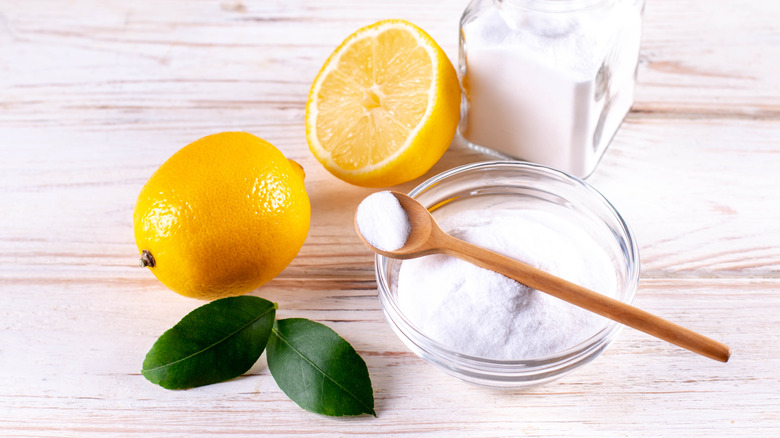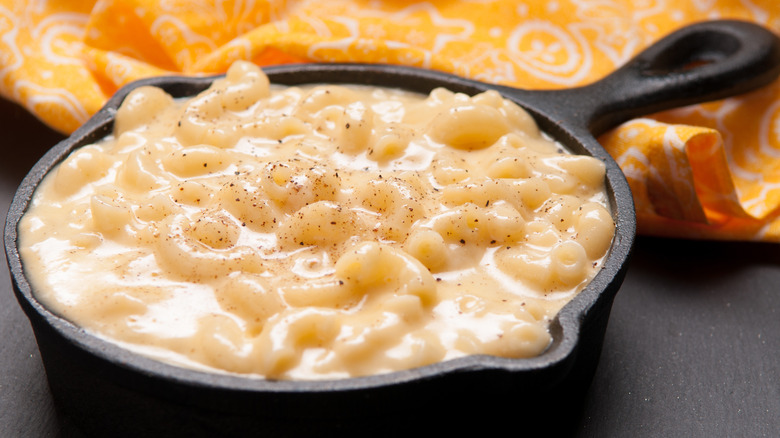Lemon Juice And Baking Soda Are The Key Ingredients For Gooey Cheese Sauce
If you've tried to replicate your favorite Mexican restaurant's queso fundido but ended up with a gloopy mess instead of a velvety smooth cheese sauce, lemon juice and baking soda might be the missing ingredients in your recipe. When cheese melts, the liquids (fat and water) tend to separate from the casein proteins, resulting in an unappealing, chunky sauce if there's no emulsifier to help.
Professional chefs often use sodium citrate, a magical ingredient that prevents melting cheese from curdling. It keeps the fats and proteins together, allowing everything to melt into a homogeneous, glorious cheese sauce. Sodium citrate acts as an binder, and is found in processed cheeses like Velveeta and American cheese. This is why some home cooks swear by including these cheeses in their mac 'n cheese recipes: They don't separate when melted.
You can buy sodium citrate at restaurant supply stores or online; it costs roughly $18 for a 14-ounce package. However, you can also make it at home using lemon juice and baking soda for a fraction of the cost. Sodium citrate allows home cooks to use a variety of cheeses and still achieve silky smooth cheese sauce results.
Sodium citrate will keep your cheese sauce silky smooth
Homemade sodium citrate is produced by combining an acid, such as lemon juice or citric acid, with baking soda. Similar to the volcano you made for your fifth-grade science project, the ingredients will froth a bit once combined. Once the bubbling stops, however, you'll be left with sodium citrate, which you can safely incorporate into your chosen cheese sauce recipe without the cheese coagulating.
In fact, our nacho cheese sauce recipe utilizes sodium citrate, made by combining two teaspoons of citric acid with two and a half teaspoons of baking soda. Just note that if you're using weaker acids like citrus fruit juices or vinegar — which both contain water — and you opt for citric acid, it needs to be dissolved in water before adding any other liquids to the recipe. Our nacho cheese sauce uses milk to create a luxurious texture.
Heat the liquids to a simmer, and then gradually whisk in your favorite cheese until it has fully melted and the sauce is smooth and silky. Since the baking soda neutralizes the acid, there's no need to worry about a citrusy taste. The sauce will thicken as it cools but should remain pourable at room temperature.
Some cheeses melt better than others
Even with sodium citrate, some cheeses melt better than others. American cheese is arguably the gold standard for grilled cheese sandwiches and burgers, but there are other varieties that offer the desired stretch and gooeyness. Save the aged cheeses for a charcuterie platter, and opt for a mix of younger varieties when making a sauce.
Pizza lovers won't be surprised that mozzarella tops the list of excellent melting cheeses. Mild in flavor, shredded mozzarella works exceptionally well in white sauces, especially those used in baked pasta dishes. Fontina is another Italian favorite, known for its pungent taste, while provolone offers a sharper kick. For a touch of funk — a quality often associated with blue cheeses — try Taleggio, which has a tangy fruitiness.
If you prefer something sharper, opt for cheddar. Both white and yellow cheddar serve as the base for queso dips that pair well with a variety of foods. For a saucier cheeseburger, top the patty with a cheddar cheese sauce and toss in some diced jalapeños if you like it spicy.
Gruyère, a variety of Swiss cheese often found melted on top of French onion soup, is another nutty option frequently used in fondue. Swiss raclette, traditionally used to blanket boiled potatoes and pickled vegetables, also melts well. If you're struggling to get certain family members to eat their vegetables, a cheese sauce could be your secret weapon. Just whip one up and watch them suddenly enjoy their broccoli.



